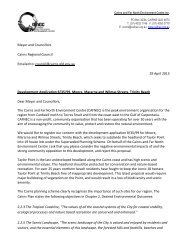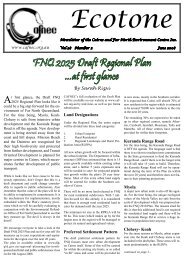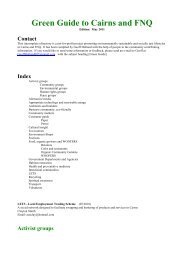Cairns Bruce Highway Upgrade and Cairns Transit ... - CAFNEC
Cairns Bruce Highway Upgrade and Cairns Transit ... - CAFNEC
Cairns Bruce Highway Upgrade and Cairns Transit ... - CAFNEC
Create successful ePaper yourself
Turn your PDF publications into a flip-book with our unique Google optimized e-Paper software.
-4-Northern Australia L<strong>and</strong> <strong>and</strong> Water Taskforce: Final ReportThe Final Report of the L<strong>and</strong> <strong>and</strong> Water Taskforce identifies NorthernAustralia’s unique natural <strong>and</strong> cultural heritage, community values<strong>and</strong>, above all, physiological limitations to development. Their Final Reportshould put to rest notions of wide spread, broad-scale agriculturaldevelopment turning the north into a major food bowl for Asia or Australia.Established in 2007 under a Coalition Government, the L<strong>and</strong> <strong>and</strong> WaterTaskforce was established to examine the development potential ofNorthern Australia in response to the 2004 National Water Initiative.The Taskforce originally had a narrow focus of identifying the capacity ofl<strong>and</strong> <strong>and</strong> water resources for future agricultural development. However,when the federal election was called in November 2007 the Taskforcewas temporarily suspended. In September of 2008, the newly electedRudd Government revised the terms of reference <strong>and</strong> membership ofthe Taskforce. Changes to the membership of the Taskforce included thereplacement of party-political individuals to an independent <strong>and</strong> broaderrepresentation of experts from a variety of relevant disciplines.With revised terms of reference <strong>and</strong> a membership spanning western science,Indigenous knowledge, research, conservation, pastoralism, mining,agriculture, farming <strong>and</strong> water policy, the Taskforce has spent nearlytwo years investigating:• The sustainable capacity of northern river systems <strong>and</strong> basins for increasedconsumptive uses;• Opportunities for economic development <strong>and</strong> diversification of uses(including non-consumptive) of locally <strong>and</strong> regionally significant water resourcesconsistent with sustainable resource use principles;• The potential impacts arising from identified development opportunitieson natural values <strong>and</strong> broader community values;• Incentive, market regulatory <strong>and</strong> planning mechanisms to ensure futuredevelopment is consistent with the National Water Initiative;• Potential cross-jurisdictional governance arrangements for surface <strong>and</strong>groundwater resources.The study area for the L<strong>and</strong> <strong>and</strong> Water Taskforce stretched from justnorth of <strong>Cairns</strong> across to Broome encompassing river basins on CapeYork Peninsula’s east coast, the Gulf of Carpentaria <strong>and</strong> the Timor Sea.Guided by a set of principles that acknowledged Northern Australia’sdistinct demographics, community attitudes, Indigenous rights <strong>and</strong> interests,heritage values including the intact nature of many freshwaterecosystems, knowledge systems <strong>and</strong> adaptation to climate change, theTaskforce has delivered a report calling for a coordinated approach togenuine sustainability.By Andrew PiconeIn identifying economic development <strong>and</strong> diversification opportunities,the Taskforce considered both consumptive <strong>and</strong> non-consumptive usesof water resources. Key findings were that the north’s environmentalvalues were of global significance <strong>and</strong> conservation <strong>and</strong> l<strong>and</strong> <strong>and</strong> watermanagement are integral to northern Australia’s economy. In addition, theTaskforce recognises that around 90% of the north’s l<strong>and</strong> area supports abeef cattle industry. There are also opportunities for economic advancementwithin the Indigenous estate through the provision of commercial<strong>and</strong> customary services. The potential water resources for a 100 to 200per cent increase in irrigated l<strong>and</strong> <strong>and</strong> a mosaic approach to agricultureacross the north should be further investigated.The impacts of the above mentioned opportunities were also consideredby the Taskforce. Again, lack of data limited the Taskforce’s ability to adequatelyidentify potential impacts, particularly in relation to the interconnectedflow of groundwater <strong>and</strong> surface water. Subsequently, the precautionaryprinciple should apply. Unmanaged l<strong>and</strong> was recognised by theTaskforce as an environmental <strong>and</strong> cultural liability <strong>and</strong> it was identifiedthat it is the responsibility of l<strong>and</strong>holders to provide stewardship.Importantly, the Taskforce identified the impacts of rapid large scale development<strong>and</strong> the impacts these developments have on communities.Their recommendations encouraged a coordinated response to l<strong>and</strong>scaperestoration <strong>and</strong> sustainable production <strong>and</strong> action to improve theresilience of natural systems through market based incentives particularlyon Indigenous l<strong>and</strong>s. Further, the expansion of the national reserve systemneeds continued government support. An urgent priority for governmentsis ensuring all northern Australian communities can access drinkingwater <strong>and</strong> any future developments must not negatively impact onthis resource.Key findings relating to incentive, market regulatory <strong>and</strong> planning mechanismsto ensure future development is consistent with the National WaterInitiative addressed a variety of impediments centred on process, deliveryof existing policy <strong>and</strong> Indigenous rights. According to the Taskforce, thereare a range of impediments stemming from tenure, divergent jurisdictionalprocesses, inadequacies in planning <strong>and</strong> the delivery of servicesthat impedes the north’s potential. The Taskforce asserts that the NationalWater Initiative is an effective framework for delivering sustainable waterresource management but that its implementation is too slow. Further,the importance of Indigenous rights in water allocation needs to be explicitlyrecognised in statutory processes including recommendations oncultural water allocations <strong>and</strong> that there is an equitable allocation for consumptiveuses <strong>and</strong> support for the Indigenous purchase of water fromconsumptive allocations.The Taskforce has called for a strategic focus, national leadership <strong>and</strong>recognition of the north’s ongoing contribution to national prosperity todeliver an integrated <strong>and</strong> sustainable region in addition to identifying theimperative of ‘Closing the Gap’ for Indigenous Australians.Fifteen recommendations arose out of the Taskforce’s findings addressingeach of the terms of reference.On the sustainable capacity of northern rivers <strong>and</strong> basins, the Taskforceidentified the acute lack of data on climate, l<strong>and</strong>, water <strong>and</strong> environmentalattributes <strong>and</strong> a lack of underst<strong>and</strong>ing of Indigenous knowledge. Theseinformation gaps are a hindrance to quantifying sustainable water usefor varied uses. In addition, little is known about groundwater resources<strong>and</strong> the risk of salinity associated with its utilisation. The Taskforce alsoidentified that there is a disparity in measuring the values of water betweensocial, cultural <strong>and</strong> economic uses. In response the Taskforce hasrecommended that a range of data continue to be collected on biophysical,geological <strong>and</strong> socio-economic attributes <strong>and</strong> analysed to inform regional,catchment <strong>and</strong> local planning decisions.With regard to governance, the Taskforce notes that there are greatersynergies between cross-jurisdictional east-west relationships than withsouthern cities such as Brisbane, Canberra or Perth. But these are notreflected within administrative bureaucracies. To properly implement theNational Water Initiative, the Taskforce recommend that there should befar greater coordination between northern regions across the jurisdictions.On this they propose a Northern Australia L<strong>and</strong> <strong>and</strong> Water Authorityto be based in the north to improve northern institutional capacity <strong>and</strong>advocate for the north.The Taskforce also calls for a Council of Northern Australia, to be chairedby the Prime Minister, to provide leadership in working with the States <strong>and</strong>Territory to develop a vision for a sustainable future for northern Australia.Above is essentially a summary of the Taskforce’s Final Report. It presentssome major opportunities for advancing the principles of ecologicalsustainability across the north, including Far North Queensl<strong>and</strong>.For more information: National Water Initiative:www.nwc.gov.au/www/html/117-national-water-initiative.asp<strong>and</strong> the Northern Australia L<strong>and</strong> <strong>and</strong> Water Taskforce: www.nalwt.gov.au/







